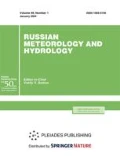Abstract
The analysis of ecological and toxicological conditions of the Tsimlyansk Reservoir and of trends of long-term variations of hydrochemical, hydrobiological, and biotesting parameters is carried out on the basis of long-term data of Roshydromet regular observations (1984–1991) and authors’ studies (1990, 2006–2007). It is revealed that, according to the complex of chemical parameters, the water pollution level decreased by the end of the period and is relatively low at present, although the pollution is of stable nature and the toxic and carcinogenic compounds are discovered in the water and in bottom sediments. The most dangerous display of the reservoir eutrophication is a “bloom” of algae characterized by the prevalence of blue-green algae (Cyanophyta) amounting to 100% of the total biomass in some samples; the species being able to discharge the toxins to the water (Aphanisomenon flos-aquae, Microcystis aeruginosa, Anabaena flos-aquae) often prevail. During biotesting, the samples of water and bottom sediments in a number of cases exerted a toxic effect on the water organisms and, most likely, the toxicity increases with time. Although different parts of the reservoir differ considerably in ecological and toxicological parameters, an ecologically unfavorable situation emerged in the reservoir ecosystem due to the pollution, eutrophication, and toxicophication.
Similar content being viewed by others
References
Water Ecosystem of the Lower Don: Long-term Variations of Water Quality (Gidrometeoizdat, St. Petersburg, 2006) [in Russian].
N. V. Golubova, “Argillaceous Sediments in the Tsimlyansk Reservoir,” in Proceedings of the Geological and Geographical Department (Rostov Gos. Univ., Rostov-on-Don, 2004) [in Russian].
State Report “On Environmental Conditions and Natural Resources of Rostov Oblast in 2003,” in Ecological Bulletin of the Don River (Administration of Rostov Oblast, Committee for Protection of Environment and Natural Resources of the Administration of Rostov Oblast, Rostov-on-Don, 2004) [in Russian].
Yearbooks. Quality of Surface Waters of the Russian Federation (Gidrometeoizdat, St. Petersburg, 2003–2005) [in Russian].
I. V. Kozhevnikov, N. A. Kozhevnikova, and N. E. Skorobogat’ko, “The Study of Potential Microcystine Toxicity of Cyanophyta in the Krasnoyarsk Reservoir,” in Proceedings of the 3rd All-Russian Conference on Water Toxicology in Memory of B. A. Flerov. Anthropogenic Impact on Water Organisms and Ecosystems, Borok, November 11-16, 2008, Part 3 (OOO Yaroslavskii Pechatnyi Dvor, Borok, 2008) [in Russian].
A. M. Nikanorov, T. A. Khoruzhaya, and E. A. Flik, “A Possibility of Quantitative Estimation of Ecological Danger of Pollution of Water of Southern Russian Reservoirs with Heavy Metals,” Vestn. Yuzhnogo Nauchn. Tsentra (Southern Res. Center Bull., No. 3 (2007) [in Russian].
Freshwater Ecosystems under Conditions of Anthropogenic Eutrophication. Hydrochemical Data, Vol. CXIY (Gidrometeoizdat, St. Petersburg, 1999) [in Russian].
RD 52.24.566-94. Recommendations. Methods of Toxicological Estimation of Freshwater Ecosystem Pollution (Rosgidromet, Moscow, 1994) [in Russian].
RD 52.24.309-2004. Recommendations. Organization and Implementation of Regular Observations of Surface Inland Water Pollution at the Roshydromet Network (Meteoagentstvo Rosgidrometa, Moscow, 2005) [in Russian].
Manual for the Hydrobiological Analysis of Samples and Bottom Sediments, Ed. by V. A. Abakumov (Gidrometeoizdat, St. Petersburg, 1992) [in Russian].
V. B. Sapunov, G. F. Shikunets, and Chen-Tzyn Tsyui, “Three Components of Eutrophication Process: Dynamics of Biogens, Biomass, and Biodiversity,” Ekol. Khim. (Ecol. Chem.), No. 1, 18 (2009) [in Russian].
A. D. Khovanskii, “The Tsimlyansk Reservoir as a Complex Geochemical Barrier for the Don River,” Izv. Severo-Kavkazskogo Nauchn. Tsentra Vyssh. Shkoly, Estestvennye Nauki (Izv., North Caucasian Res. Center of Higher School, Nat. Sci.), No. 2 (1989) [in Russian].
N. P. Tsyba, A. N. Pozdnyakova, and A. D. Semenov, “On the Production and Destruction of Organic Matter in the Tsimlyansk Reservoir,” Gidrokhim. Materialy (Hydrochem. Materials), No. 64 (1975) [in Russian].
I. R. Falconer, “Potential Impact on Human Health of Toxic Cianobacteria,” Phycologia, No. 35 (1996).
Author information
Authors and Affiliations
Additional information
Original Russian Text © A.M. Nikanorov, T.A. Khoruzhaya, N.A. Martysheva, 2012, published in Meteorologiya i Gidrologiya, 2012, No. 4, pp. 75–85.
About this article
Cite this article
Nikanorov, A.M., Khoruzhaya, T.A. & Martysheva, N.A. Present-day characteristics and trends of long-term changes in ecological and toxicological conditions of the Tsimlyansk Reservoir. Russ. Meteorol. Hydrol. 37, 269–275 (2012). https://doi.org/10.3103/S1068373912040085
Received:
Published:
Issue Date:
DOI: https://doi.org/10.3103/S1068373912040085



